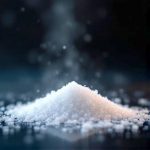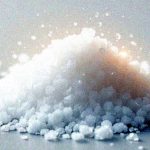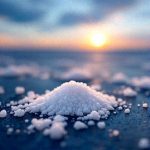Takeaways
- Sodium affects fluid balance in the body
- Excess sodium intake can lead to swelling
- Reducing sodium helps manage swelling
- Diet changes and exercise impact sodium levels
- Monitoring sodium intake supports overall health
- Medical advice is needed for persistent swelling
Understanding Sodium and Swelling
Sodium is a crucial mineral that your body needs. It plays a role in controlling the amount of fluid in your body and helps your nerves function correctly.[1] However, too much sodium can cause problems. When you eat a lot of sodium, your body tends to hold onto extra water, which can lead to swelling in different areas.[2]
Swelling, also called edema, occurs when fluid builds up in your body’s tissues. This can happen in places like your hands, feet, or ankles.[3] Sometimes, it might affect your face or abdomen. While swelling can have multiple causes, sodium intake often contributes significantly.
Many factors can lead to swelling related to sodium. Your diet is a big one; processed foods and restaurant meals often have a lot of sodium. Medical conditions, such as heart or kidney problems, can also affect how your body handles sodium. Understanding these connections can help you manage swelling more effectively.
The Science Behind Sodium-Related Swelling
Osmosis and Fluid Retention
Osmosis is how water moves between cell membranes, trying to balance the concentration of substances on both sides. When you consume a lot of salt, it increases the sodium in your blood. To dilute that excess sodium, your body retains more water, which can result in swelling in various parts of your body.[4]
Think of your body as constantly trying to maintain balance. When there’s too much sodium, your body retains water to even things out. This extra water needs a place to go, and it often settles in your tissues, which causes swelling.
Cellular Mechanisms
Your cells have tiny structures called sodium-potassium pumps. These pumps move sodium out of cells and potassium into them. This process is vital for keeping the right balance of fluids inside and outside your cells.[5] Eating too much sodium can disrupt this delicate balance.
Too much sodium can force these pumps to work harder. This extra work leads to fluid buildup both inside and around cells. This fluid accumulation is what causes swelling.[6] Recognizing these cellular processes helps explain why controlling sodium intake is so important for reducing swelling.
Types of Swelling Associated with Sodium
Sodium-related swelling can manifest in different ways. Here are some common types:
- Peripheral edema: Swelling in the legs, ankles, and feet
- Facial edema: Puffiness in the face, especially around the eyes
- Abdominal bloating: Swelling in the stomach area
- Hand edema: Swelling in the hands and fingers
Peripheral edema is a common form of swelling. It can make your shoes feel tight or leave a temporary indent when you press on your skin.[7] Facial edema might be less obvious, but it can make your face look puffy. Abdominal bloating can cause discomfort and a feeling of fullness. Hand edema may make rings feel tight or make it difficult to clench your fist.
Each type of swelling has unique characteristics, but they all share a common link to sodium intake. Understanding these different types helps you recognize and address sodium-related swelling more effectively.
Sodium in the Diet
Common Sources
Sodium is in many of the foods we eat every day. Some sources, like table salt, are obvious, while others might surprise you. Here’s a look at some common sources of sodium:
| Food Item | Sodium Content (mg per serving) |
|---|---|
| Table salt (1 tsp) | 2,325 |
| Canned soup (1 cup) | 700-1,300 |
| Deli meat (2 oz) | 500-700 |
| Pizza (1 slice) | 600-1,500 |
| Bread (1 slice) | 100-200 |
Processed foods often contain high levels of sodium. This includes items like canned vegetables, frozen dinners, and packaged snacks.[8] Even foods that don’t taste salty can be high in sodium. Bread, cereals, and cheese are common examples. Reading food labels is helpful in identifying these hidden sources.
Recommended Intake
The amount of sodium individuals need varies. The American Heart Association recommends most adults consume no more than 2,300 mg per day.[9] However, for many people, especially those with high blood pressure or heart disease risk, an ideal limit is 1,500 mg per day.
These recommended amounts can seem low compared to what many people actually consume. The average American eats about 3,400 mg of sodium per day, which is well above the recommended limit.[10] For those trying to reduce swelling, following these guidelines can make a significant difference.
It is important to note that some individuals might need different amounts of sodium. Athletes who sweat a lot might require more sodium, while those with certain medical conditions might need less. Always consult with a doctor for personalized advice.
Benefits of Sodium Reduction for Swelling
Reducing sodium can have several positive effects on swelling. When you lower your sodium intake, your body starts to release excess fluid. This can lead to a noticeable decrease in swelling, often within a few days.[11]
Reducing sodium not only helps with visible swelling but can also improve overall health. Lower sodium intake is associated with better blood pressure control, which is significant because high blood pressure can sometimes contribute to swelling.[12]
Here are some benefits of reducing sodium intake when managing swelling:
- Decreased fluid retention
- Reduced puffiness in face and extremities
- Improved blood pressure
- Better kidney function
- Reduced strain on the heart
- Improved overall comfort
These benefits can greatly affect daily life. Many people report feeling more comfortable and energetic after reducing their sodium consumption. This simple change can lead to substantial improvements in how you feel.
Strategies for Reducing Sodium Intake
Reading Food Labels
Understanding food labels is a useful tool for controlling your sodium intake. Look for the “Sodium” or “Salt” line on the nutrition facts panel. The amount is usually listed in milligrams (mg) per serving.[13] Always check the serving size as well, as sometimes what seems like one serving is actually more.
When comparing different products, pay attention to the percent daily value (%DV) for sodium. This percentage tells you how much of your daily sodium allowance is in one serving. Generally:
- 5% DV or less is low in sodium
- 20% DV or more is high in sodium
Don’t be misled by terms like “reduced sodium” or “light in sodium.” These products might still contain a significant amount of sodium. Always check the actual numbers on the food label.[14]
Cooking Techniques
How you prepare food can greatly affect its sodium content. Here are some tips for low-sodium cooking:
- Use fresh ingredients instead of canned or processed ones
- Experiment with herbs and spices for flavor instead of salt
- Try citrus juices or vinegars to add tang without sodium
- Rinse canned vegetables to remove excess sodium
- Make your own sauces and dressings to control sodium content
Gradually reducing salt in recipes can help your taste buds adjust. Over time, you may find you prefer less salty foods, making it easier to maintain a low-sodium diet in the long term.[15]
Remember, it’s not just about removing salt; it’s about adding flavor in other ways. Garlic, onions, and fresh herbs can make dishes tasty without adding sodium. Roasting or grilling vegetables enhances their natural flavors, reducing the need for salt.
Natural Alternatives to Sodium
While sodium is important for flavor, there are several natural alternatives that can enhance taste without increasing the risk of swelling. Here’s a comparison of some popular options:
| Alternative | Flavor Profile | Benefits |
|---|---|---|
| Lemon juice | Tart, bright | Rich in vitamin C, antioxidants |
| Garlic | Savory, pungent | May lower blood pressure |
| Cumin | Earthy, warm | Aids digestion |
| Turmeric | Slightly bitter, warm | Anti-inflammatory properties |
| Vinegar | Acidic, tangy | May help regulate blood sugar |
These alternatives not only add flavor but also provide their own health benefits. Lemon juice, for instance, can brighten dishes while providing vitamin C. Garlic adds depth to meals and may help lower blood pressure. Cumin adds warmth to dishes and can aid digestion.
Herbs such as basil, oregano, and thyme are also great choices. They add complex flavors without any sodium. Fresh herbs are especially flavorful, but dried herbs also work well. Experiment with different combinations to find your favorite flavors.
Using these alternatives can help manage swelling in two ways. First, they reduce your overall sodium intake. Second, many of these options have anti-inflammatory properties, which can help reduce swelling even more.
Exercise and Sodium Balance
Exercise plays an important role in how your body handles sodium. When you sweat, you lose both water and sodium. For most people, this helps balance the sodium they consume through food.[16] However, it’s vital to replace lost water to avoid dehydration.
Regular exercise can improve how your body regulates sodium. It helps your kidneys work more efficiently, removing excess sodium from your system.[17] This can lead to improved fluid balance and less swelling over time.
Here are some exercises that can help reduce swelling:
- Walking
- Swimming
- Cycling
- Yoga
- Pilates
These activities promote circulation and help move excess fluid out of the tissues. They also support overall heart and kidney health, which is essential for long-term sodium balance.
Remember to drink water before, during, and after exercise to replace fluids lost through sweat. However, be cautious not to overdo it. Drinking too much water can dilute the sodium in your blood, which can be dangerous.
For most people, plain water is sufficient for hydration during exercise. However, if you’re exercising intensely for more than an hour, a sports drink may be beneficial. These drinks contain sodium and other electrolytes to replace what you lose in sweat.
Sodium and Specific Health Conditions
Heart Health
Sodium has a direct impact on heart health. Too much sodium can lead to high blood pressure, putting extra strain on your heart and blood vessels. Over time, this can increase the risk of heart disease and stroke.[18]
For people with heart conditions, managing sodium is particularly crucial. Excess sodium can cause fluid buildup around the heart, making it work harder to pump blood. It can also worsen symptoms of heart failure, such as shortness of breath and swelling.
Reducing sodium intake can help lower blood pressure. Even small reductions can make a significant difference. For many individuals, this means less reliance on blood pressure medications. It also reduces the heart’s workload, which can help prevent further complications.
Kidney Function
Your kidneys are essential for sodium regulation. They filter your blood and remove excess sodium through urine. Consuming too much sodium puts extra stress on your kidneys, potentially leading to kidney damage over time.[19]
For people with kidney disease, sodium management is vital. Damaged kidneys struggle to remove excess sodium and fluid, leading to swelling, high blood pressure, and further kidney damage. A low-sodium diet can help reduce the strain on the kidneys.
Even for people with healthy kidneys, a balanced sodium intake is important. It helps maintain proper kidney function and prevents unnecessary strain, particularly as kidney function naturally declines with age.
Monitoring Sodium Intake
Keeping track of your sodium intake is a useful way to manage swelling. It helps you understand your eating patterns and make informed choices. Here’s how to effectively monitor your daily sodium intake:
- Keep a food diary: Write down everything you eat and drink
- Read food labels: Note the sodium content of packaged foods
- Use a nutrition app: Many apps can track sodium intake automatically
- Measure portions: Use measuring cups to ensure accuracy
- Be aware of restaurant meals: Ask for nutrition information when dining out
Consistency is important when tracking sodium intake. Try to monitor your intake for at least a week to get a clear picture of your typical sodium consumption. You might be surprised by what you discover.
Once you have this information, you can start making changes. Identify high-sodium items in your diet that you can reduce or replace. Set realistic goals for sodium reduction. Remember, small changes can add up to significant results over time.
Regular monitoring can also help you see the results of your efforts. You might notice less swelling or improved energy as you reduce your sodium intake, which can be motivating and help you maintain your goals.
When to Seek Medical Advice
While managing sodium intake can help with swelling, sometimes professional medical help is necessary. Here are some signs that you should see a doctor:
- Sudden or severe swelling
- Swelling accompanied by shortness of breath
- Swelling that doesn’t improve with lifestyle changes
- Swelling in only one limb
- Pain or redness in the swollen area
- Unexplained weight gain along with swelling
These symptoms could indicate underlying health issues such as heart failure, kidney disease, or blood clots that can cause swelling. A doctor can diagnose the cause and provide the necessary treatment.
It’s also crucial to consult a doctor before making major changes to your diet, especially if you have existing health conditions or take medications. Some medications can affect sodium levels in the body.[20] Your doctor can help you find the right balance.
Remember, while reducing sodium can be helpful, it isn’t a cure-all. Persistent or severe swelling should always be evaluated by a medical professional. They can provide a comprehensive treatment plan tailored to your specific needs.
FAQ
These questions reflect common concerns about sodium and swelling. They highlight the complex relationship between sodium intake, hydration, and overall health. While general guidelines are useful, individual needs can vary. Always consult with a healthcare provider for personalized advice.Can drinking more water help reduce sodium-related swelling?
How quickly can reducing sodium intake affect swelling?
Are there any risks to drastically cutting sodium from my diet?
Can certain medications contribute to sodium-related swelling?
Is sea salt a healthier alternative to table salt for managing swelling?
How does altitude affect sodium levels and swelling?
Sodium is a critical electrolyte involved in maintaining fluid balance, nerve impulse transmission, and muscle contraction. It’s essential for various physiological processes.
Source: “Sodium Content in Pre-Packaged Foods in China: A Food Label Analysis” https://www.ncbi.nlm.nih.gov/pmc/articles/PMC10708419/
Excess sodium in the bloodstream increases water retention via osmosis, leading to fluid buildup in tissues and subsequent swelling (edema).
Source: “Quality of fluid balance charting and interventions to improve it: a systematic review” https://www.ncbi.nlm.nih.gov/pmc/articles/PMC10729040/
Edema is a common clinical sign characterized by fluid accumulation in the interstitial spaces of the body, leading to visible swelling. This can occur in various areas, with peripheral edema (hands, feet, ankles) being most common.
Source: “Alterations in brain fluid physiology during the early stages of development of ischaemic oedema” https://www.ncbi.nlm.nih.gov/pmc/articles/PMC11163777/
When blood sodium levels increase, water moves from tissues into the bloodstream via osmosis to dilute the sodium concentration. This excess water in the bloodstream can contribute to fluid retention and swelling.
Source: “Removal of Heavy Metals from Wastewaters and Other Aqueous Streams by Pressure-Driven Membrane Technologies: An Outlook on Reverse Osmosis, Nanofiltration, Ultrafiltration and Microfiltration Potential from a Bibliometric Analysis” https://www.ncbi.nlm.nih.gov/pmc/articles/PMC11355994/
The sodium-potassium pump actively transports sodium out of cells and potassium into cells, creating a concentration gradient that is vital for maintaining cell volume and fluid balance, as well as nerve and muscle function.
Source: “Structural basis for gating mechanism of the human sodium-potassium pump” https://www.ncbi.nlm.nih.gov/pmc/articles/PMC9458724/
Excess sodium intake can disrupt the normal function of sodium-potassium pumps, potentially leading to fluid buildup both inside and outside cells, which can contribute to swelling. This process impacts overall fluid balance.
Source: “Structural basis for gating mechanism of the human sodium-potassium pump” https://www.ncbi.nlm.nih.gov/pmc/articles/PMC9458724/
Peripheral edema is characterized by swelling in the extremities, such as the feet, ankles, and lower legs. It often manifests with symptoms such as difficulty fitting into shoes and the development of a temporary pit or indent when pressed on the skin.
Source: “Alterations in brain fluid physiology during the early stages of development of ischaemic oedema” https://www.ncbi.nlm.nih.gov/pmc/articles/PMC11163777/
Processed foods often have added salt for preservation and flavor, resulting in high sodium content, examples include canned goods, frozen meals, and packaged snacks.
Source: “Sodium Content in Pre-Packaged Foods in China: A Food Label Analysis” https://www.ncbi.nlm.nih.gov/pmc/articles/PMC10708419/
The American Heart Association (AHA) recommends that most adults limit their daily sodium intake to no more than 2,300 milligrams, with an ideal limit of 1,500 mg for those with high blood pressure or heart disease risk.
Source: “The C. elegans Myc-family of transcription factors coordinate a dynamic adaptive response to dietary restriction” https://www.ncbi.nlm.nih.gov/pmc/articles/PMC10690244/
The average American adult consumes about 3,400 mg of sodium daily, which is substantially above the recommended limit of 2,300 mg (and ideally 1,500 mg for some) set by health organizations like the American Heart Association.
Source: “Sodium Content in Pre-Packaged Foods in China: A Food Label Analysis” https://www.ncbi.nlm.nih.gov/pmc/articles/PMC10708419/
Lowering sodium intake can help the body release excess fluid through urine. The reduction in fluid retention can often lead to noticeable decreases in swelling within a few days to a week for some individuals.
Source: “Sex-specific associations between sodium and potassium intake and overall and cause-specific mortality: a large prospective U.S. cohort study, systematic review, and updated meta-analysis of cohort studies” https://www.ncbi.nlm.nih.gov/pmc/articles/PMC10960470/
Reducing sodium intake can lead to a decrease in blood pressure, as excess sodium can cause the body to retain water, increasing blood volume and pressure. High blood pressure can contribute to fluid retention and swelling.
Source: “Dietary reference values for sodium” https://www.ncbi.nlm.nih.gov/pmc/articles/PMC7009309/
Nutrition labels will provide the amount of sodium in milligrams per serving, typically found under the sodium or salt line, which can be used to monitor intake.
Source: “ESPGHAN 56th Annual Meeting Abstracts” https://www.ncbi.nlm.nih.gov/pmc/articles/PMC11094350/
Terms like ‘reduced sodium’ or ‘light in sodium’ do not guarantee low sodium. Always check the specific nutrition label to understand the actual mg of sodium per serving, as these products may still contain a significant amount of sodium.
Source: “Sodium Content in Pre-Packaged Foods in China: A Food Label Analysis” https://www.ncbi.nlm.nih.gov/pmc/articles/PMC10708419/
Taste buds can adapt to lower salt levels over time, making less salty foods more palatable. This gradual adjustment makes maintaining a low-sodium diet easier in the long term.
Sweating involves the loss of both water and sodium, and this loss helps in maintaining electrolyte balance for most people, provided fluid and sodium intake from food and beverages are adequate.
Regular physical activity can enhance kidney function, leading to more efficient removal of excess sodium from the body, promoting better overall sodium balance, but be sure to replace lost fluids.
Excess sodium intake contributes to elevated blood pressure, which increases the risk of heart disease and stroke due to added strain on the heart and blood vessels.
Source: “Mechanism-based strategies to prevent salt sensitivity and salt-induced hypertension” https://www.ncbi.nlm.nih.gov/pmc/articles/PMC9069470/
The kidneys play a crucial role in sodium regulation by filtering blood and removing excess sodium through urine, however, consuming excessive amounts of sodium puts additional strain on the kidneys, potentially leading to damage over time.
Source: “Quality of fluid balance charting and interventions to improve it: a systematic review” https://www.ncbi.nlm.nih.gov/pmc/articles/PMC10729040/
Major dietary changes should be discussed with a doctor, particularly for individuals with pre-existing health conditions or those taking medications as some medications can affect sodium levels. Medical guidance is essential for personalized advice and care.
Adequate water intake helps the body eliminate excess sodium, which can reduce fluid retention and swelling, despite being a counterintuitive idea that might make swelling worse.
Some people might see changes within days but the full reduction in swelling could take several weeks with consistent low-sodium diet adherence. Sustained dietary changes are required to see long term results.
Reducing sodium intake too rapidly or excessively can result in headaches, fatigue, and in severe cases, potentially more serious health issues, because sodium is needed in the body for nerve, fluid and muscle function.
Some medications, such as certain blood pressure medications and steroids, can affect the body’s sodium balance and cause fluid retention, which can lead to swelling or other fluid balance issues.
Sea salt and table salt contain similar amounts of sodium by weight. While sea salt might contain some trace minerals, it doesn’t offer a significant reduction in sodium intake compared to table salt, making it a poor substitute in a low-sodium diet.
At high altitudes, the body initially experiences increased urination and fluid loss, which may temporarily reduce swelling. However, as the body acclimatizes, it tends to retain more sodium and water, which can result in swelling, particularly in the hands and feet.



